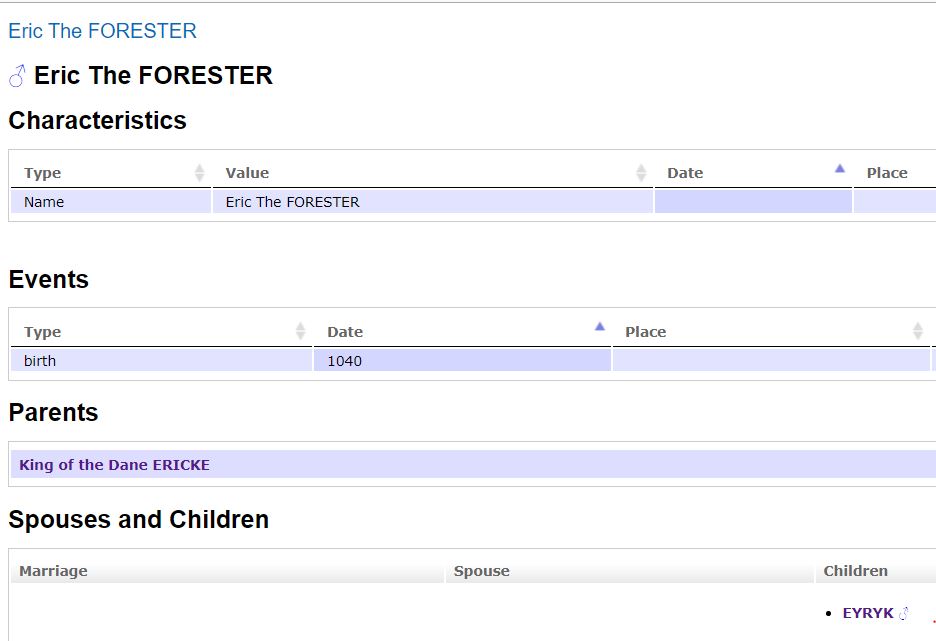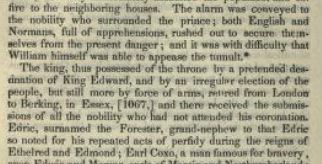Eric the Forester (14)
- Birth: ABOUT 1040
- Death:
Father: Ericke King of East Anglia (13)
Mother:
Spouse:
Next: Eryrk
- Sex: M


Biography Notes…
Grandson of Leif Eriksson? https://exploration.marinersmuseum.org/subject/leif-eriksson/
Eadric the Wild (or Eadric Silvaticus), also known as Wild Edric,[1] Eadric Cild (or Child[2]) and Edric the Forester,[3] was an Anglo-Saxon magnate of Shropshire and Herefordshire who led English resistance to the Norman Conquest, active in 1068–70.
Raised an army from his extensive lands in Leichester, England, to oppose the invasion of William the Conqueror. He lost both the battle and his lands. He was taken in by Prince William, commanded his forces, then was allowed to go home to Leicestershire (from Knowltons, 1897 and Lord- Locke 1836).
Abigail Erick of Leicestershire descended from the most ancient family of the Ericks, who derived their lineage from Erick the Forester, a great commander, who raised an army to oppose the invasion of William the Conqueror, by whom he was vanquished, but afterwards employed to command that Prince’s forces, and in his old age retired to his’ house in Leistershire, where his family have continued ever since, but declining every age, are now in the condition of very private gentlemen. The family of Eric, which has produced many eminent men, is still represented by two respectable branches, the Heyricks of Leicestertown, and the Herricks of Beau-Manor.
William I, 1066-1087
William I (William Duke of Normandy, William the Conqueror) 1066-1087
In person, William I was said to be a man of great stature with the thundering voice one might expect from one of history’s most remarkable figures. William became Duke of Normandy when he was just 7 years old, and by age 24 he was the mightiest feudal lord in France.
In 1066 William seized the English crown at the momentous Battle of Hastings. During his reign, William established a social order that would endure for centuries, and would become known as the feudal system. Although never popular with the English Saxon population, William’s iron rule brought order and stability. William ordered the creation of the Domesday Book – an exhaustive census of all of England’s people and property.
William died in 1087 while warring with Philip I in France.
Accounts of Eadric’s act of rebellion in Herefordshire in 1067 are included in Manuscript D the Anglo-Saxon Chronicle, John of Worcester‘s Chronicle and Orderic Vitalis.[7]
After the Conquest of England by William of Normandy, Eadric refused to submit and therefore came under attack from Norman forces based at Hereford Castle, under Richard fitz Scrob.
He raised a rebellion and, allying himself with the Welsh prince of Gwynedd and Powys, Bleddyn ap Cynfyn, and his brother Rhiwallon ap Cynfyn, he unsuccessfully attacked the Norman Hereford Castle in 1067. They did not take the county, and retreated to Wales to plan further raiding.[8]
During the widespread wave of English rebellions in 1069–70, he burned the town of Shrewsbury and unsuccessfully besieged Shrewsbury Castle, again helped by his Welsh allies from Gwynedd, as well as other English rebels from Cheshire.
It was probably this combination of forces which was decisively defeated by William in a battle at Stafford in late 1069. Eadric apparently submitted to King William in 1070 and later participated in William’s invasion of Scotland in 1072.[9] Another account states that he was captured by Ranulph de Mortimer “after long struggles and handed over to the king for life imprisonment, some of his lands afterwards descending to the abbey”[citation needed] of Wigmore.
He campaigned in Maine for King William in 1072 and according to the Mortimer genealogy held Wigmore Castle against Ranulph de Mortimer during the rebellion of 1075.
Next: Eryrk
